How to plant a hydrangea in spring in open ground: planting rules for garden (large-leaved), paniculate and tree-like
Hydrangea is by far one of the finest flowering shrubs to be found in home gardens.
If you cannot imagine your garden in the spring without this breathtaking beauty, then it is quite natural that you want to learn as much as possible about how to choose the right seedling, how to plant, how to care for the shrub after planting in open ground in order to wait for enviable growth and catchy flowering. Read about all this below!
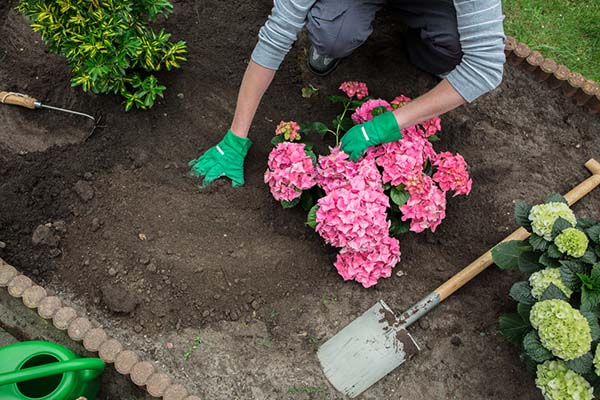
Content
Types of hydrangea
The main types of hydrangea that can be successfully grown in our regions are:
- Large-leaved (garden);
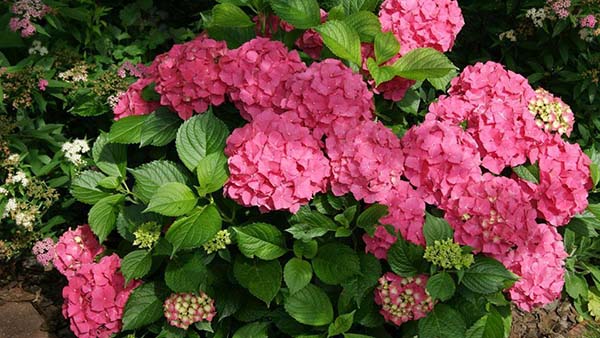
- Paniculata;

- Tree-like;
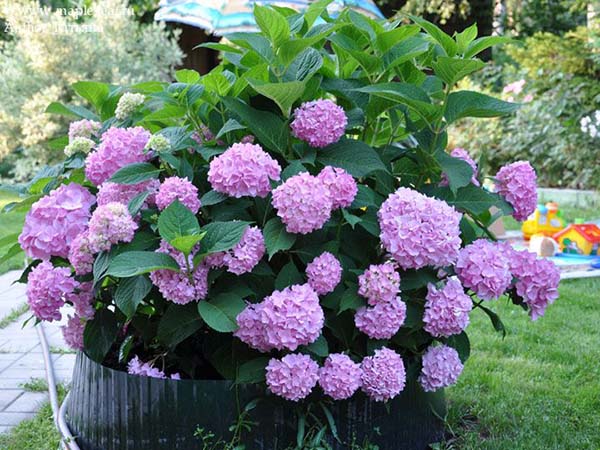
Video: varieties of tree hydrangea
- Bretschneider;
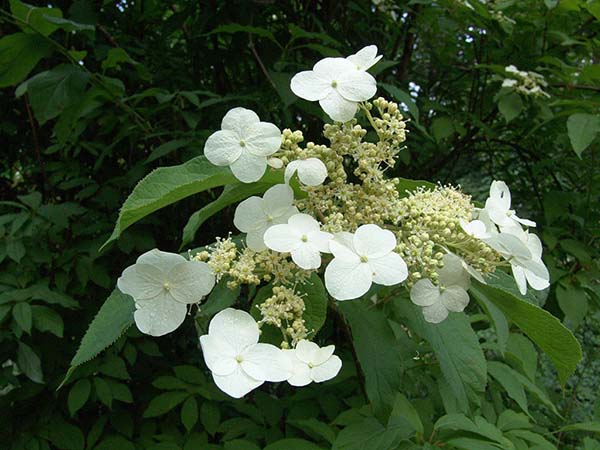
Video: types and varieties of hydrangeas
Planting hydrangeas in spring
There are several main ways to breed hydrangeas:cuttings, dividing the bush and layering. You can also grow a shrub from seeds, but it is too long and difficult.
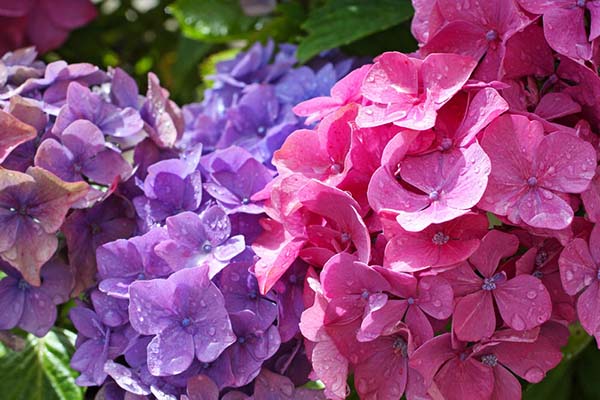
Optimal timing
In the spring, hydrangea is planted in open ground, as a rule, in the colder (northern) regions of the country: in the Central zone (Moscow region), as well as in the Urals and Siberia. But in the fall - in the southern regions (for example, in the Krasnodar Territory, in the Kuban). This is because the seedlings must have time to root in order to survive the winter. It is noteworthy that shrub seedlings with a developed root system can be planted quite successfully in open ground in the fall, regardless of the climatic characteristics of the region.
The optimal time for the spring planting of hydrangeas is April, although this can be done in May.
According to the lunar calendar in 2021
Choose the optimal date for planting seedlings can help you Moon calendar.
So auspicious days for the spring planting of hydrangeas in 2021 according to the lunar calendar are:
- in March - 4-6, 12-14, 26-31;
- in April - 1, 2, 5-7, 9, 13-15, 24, 25;
- in May - 2-6, 15-17, 20, 21, 25-31;
- in June - 2-4, 6-9, 11-14, 23-25.
Unfavorable days according to the lunar calendar for 2021 for planting hydrangeas in spring, the following dates are (days of the Full Moon and New Moon, as well as the period when the Moon is in Aquarius, since this is a barren and dry sign -italicized):
- in March -9-10, 13, 28;
- in April - 5-6, 12, 27;
- in May -2-4, 11, 26, 30-31;
- in June -10, 24, 26-27.
Place in the garden
Finding a site for growing hydrangeas is not so easy. It is optimal to find such a place so that in the morning or in the evening the flower is pleasing to the sun, and most of the time the bush rested in a light shade.

Hydrangea loves well-moistened soil. This is the flower that drinks a lot of water and always drinks.
When choosing a specific place in a summer cottage, you should take into account that you need to plant a shrub near garden paths at some distance (preferably about a meter from them), otherwise the spreading branches of a bush during their abundant flowering will close your path and have to tie them up.
Landing pit and soil
The size of the planting pit depends on the size of the seedling itself and the need to add additional components to create the most suitable soil in terms of composition. Therefore, if you need to additionally add sand, humus and other fertilizers to the pit, then it should be made more. For example, for 1-2 year old young hydrangea seedlings, it will be enough to dig a planting hole measuring 30 by 30 cm, but for large and adults 4-5 years old - 50 by 50 cm.
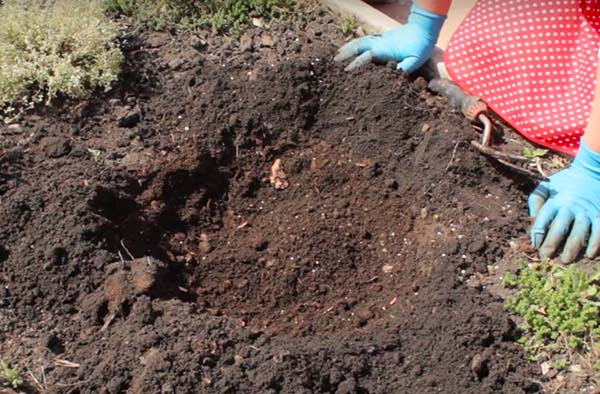
Hydrangea will grow well only in soil, the acidity of which ranges from 5.2 to 5.5 (maximum up to 6.2 pH). To make the soil more acidic, you need to add moor peat (also called brown) to the pit, sawdust of coniferous trees, coniferous litter.
In addition to organic matter, you can add minerals to the mixture - superphosphate (60-80 grams) and potassium sulfate (30-40 grams). Remember to mix everything thoroughly.
Important! Cannot be added to formula dolomite flour, lime and wood ashsince - these are soil deoxidizers, but we, on the contrary, need to make the soil more acidic, i.e. acidifiers are required.
Direct landing
Step-by-step instructions for planting a hydrangea seedling in spring in open ground:
- Choose the best place.
- Prepare the planting pit and pre-apply the necessary fertilizers to it.
- If you have an open root system, then make a slight rise from the soil mixture. If it's closed, then don't.
- Next, place the seedling on a mound and gently spread the root system of the plant (if it is an open root system).
- Then fill it with soil up to the root collar and 3-4 centimeters higher (if you deepen it excessively, it may start to rot) and tamp it slightly.
- Water abundantly and evenly. You can directly in the center of the bush and around the edge.

- If the earth falls down, then be sure to add extra. The procedure for watering and adding soil is best done several times (at least 2). This will help get rid of the air between the roots and the ground.
- Mulch the trunk circle with pine bark, sawdust or peat. Such a procedure will not only contribute to better moisture retention, but also acidify the soil. Also, to acidify the soil, you can add colloidal sulfur (about 2 tablespoons), scattering it again along the edge of the hole with the seedling, then filling it with mulch.
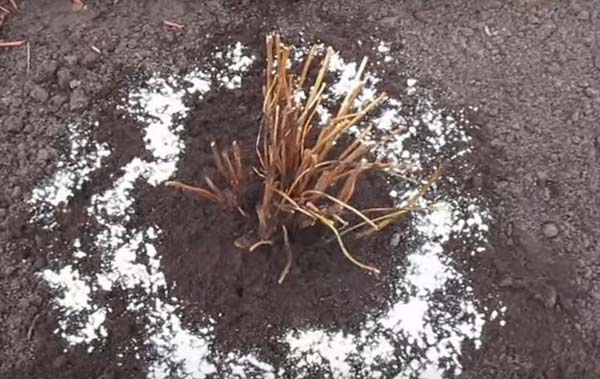
- Cut off the top of the bush. The shorter you cut, the better it will take root and the larger the inflorescences will be.
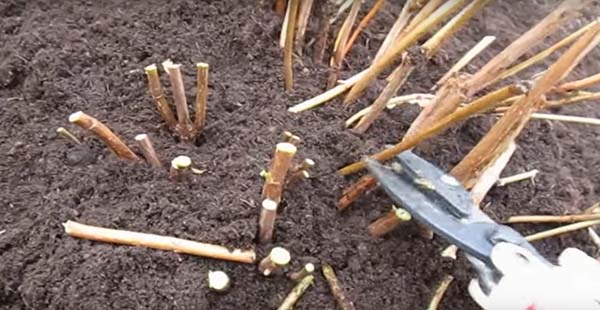
- Sprinkle with the rest of the soil-mulch remaining after cutting the hemp.
If you are going to plant several seedlings, then it is desirable that the distance between them is about 1 meter.
Video: planting a hydrangea seedling in a tree-like spring
In principle, the planting of other types of hydrangea is not particularly different, except that many gardeners advise in different ways to mulch and prune the shrub after planting.
Outdoor Hydrangea Care
The main care for hydrangea includes the following points: watering, feeding, pest and disease control, as well as pruning (in spring and autumn) and shelter for the winter. Well, do not forget about loosening the soil, which should be done at least 3 times a year to a depth of half a shovel handle (10 centimeters).

Watering
Hydrangea is a very moisture-loving shrub, it is not for nothing that in Japan it is called "yearning for water." Therefore, in summer, the soil under the plant should not be allowed to dry out. To prevent this, be sure to thoroughly mulch the plantings and do not forget to water your flowers abundantly at least once a week. If the weather is hot and dry, then the frequency of watering should be doubled.

Top dressing
If you have planted a hydrangea in good fertile and acidic enough soil, then the first 2-3 years, feeding it, as a rule, will not be required. If you have not fertilized the soil enough and have not created optimal conditions for the development of the shrub, then you will understand this by the small flowers or other "typical" signals (yellow leaves) about the lack of necessary microelements in the plant.
Note! The site already has a detailed article about feeding hydrangeas in spring and summer.
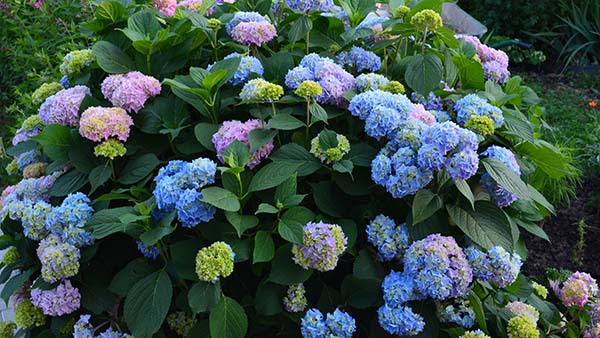
Usually feeding hydrangeas throughout the year is carried out in 4 stages.
The first stage of feeding hydrangea is early spring. To form a high-quality leaf mass, nitrogen fertilizers are required. And also a little potassium and phosphorus.
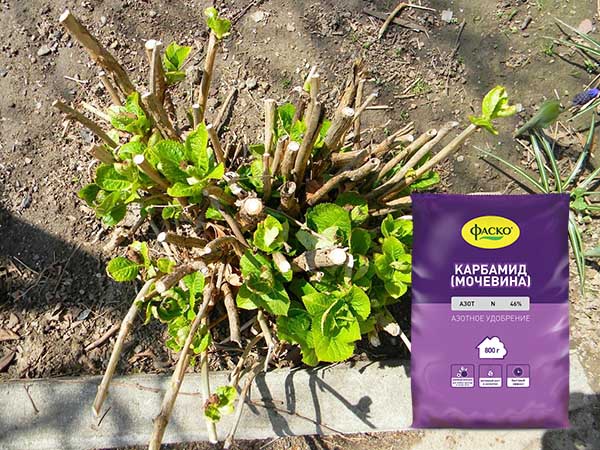
The second stage of hydrangea feeding is during the formation of buds. During the budding process, the shrub requires fertilizers with a high content of potassium and phosphorus.

The third stage of feeding hydrangeas is in the summer and flowering period. The flower again requires phosphorus-potassium fertilizers.
By the way! The site already has a detailed article about how and what to fertilize hydrangeas in spring and summer.
The final stage of feeding comes after the plant begins to fade. This usually occurs in late August and early September. After flowering, you should add superphosphate and potassium sulfate. Such feeding will contribute to the accumulation of strength by the plant in order to winter well and bloom again abundantly next year.

Advice! You can purchase specialized fertilizers for hydrangeas... Fertilizers for rhododendrons and azaleas are also great.
Garter
If you decide to grow a tree hydrangea, then due to the fact that this type of shrub is quite massive, and it has tall and long shoots, you should take care in advance that they do not accidentally break off, tying them to the supports in time (this can be done immediately after planting, at least by driving in the pegs, so as not to damage the root system later).
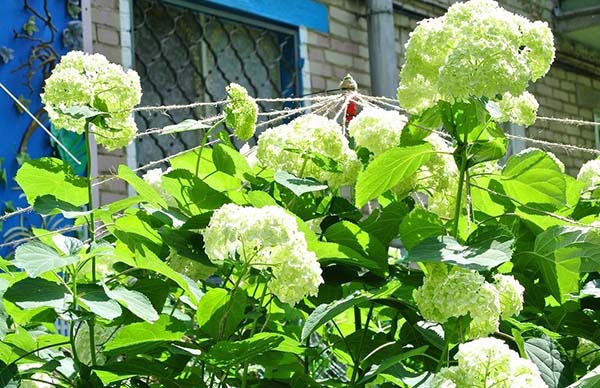
Diseases and pests
In general, hydrangea, as a rule, is not susceptible to diseases and pests and quite successfully fights them exclusively on its own.
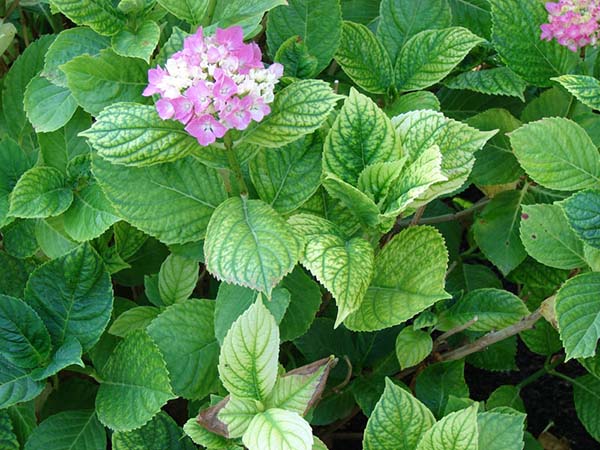
If your soil is too alkaline, it is very common for hydrangeas to develop chlorosis (the leaves turn light green, spots appear on them, and they begin to fall off, and the flower ovaries become smaller). The flower needs iron. You can, of course, dig nails or cans into the soil, but this is hardly a modern solution to the problem. Much better would be to use iron vitriol, iron chelate or iron sulfate. As soon as you add a solution prepared with one of the fertilizers, the shrub will recover pretty quickly.
Often you will notice powdery mildew on hydrangea leaves. Spraying using a Bordeaux liquid solution will help to cope with it.
You can fight other pests, such as aphids, using Fitoverm or Actellik.
Pruning and sheltering for the winter
If you do not prune the hydrangea in a timely manner, it will look very untidy. After 2-3 years, it is already worth starting to form a bush. As usual, the optimal timing is early spring (March-April) or early autumn (September). In addition, each type of shrub has its own specifics when pruning.
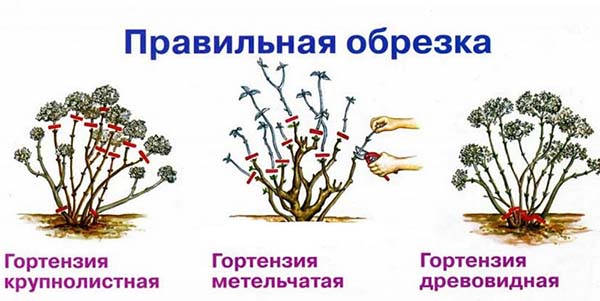
Note! Full information about spring pruning hydrangea you'll find here.
A tree-like, however, like a panicle hydrangea, does not require reinforced shelter for the winter. It is enough to mulch it well. But large-leaved is a much more delicate plant, so it is imperative to cover it.
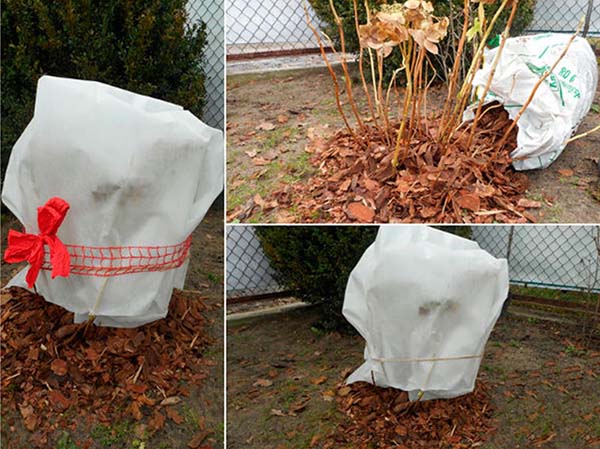
Important! In details about autumn pruning and hiding hydrangeas for the winter readin this article.
Video: preparing hydrangeas for winter - pruning and sheltering
How to correct hydrangea color and get bluer or pinkier buds
If you want to get the blue hues of hydrangea flowers, then you need to give the plant as much aluminum as possible. For this purpose (to change the color), high-moor peat, citric acid, potassium alum or ammonium alum are used. Another way would be to apply a special fertilizer Pokon "Blue Hydrangea" or Bona Forte "Rainbow". If you want to get more pink inflorescences, then you should apply a mixture of fluff lime (or just lime), ash, in other words, pink flowers appear on more alkaline soils.
Interesting! If you begin to add acidifiers to the soil only from one side, then the flowers on the same bush will be pink, blue, and even lilac.
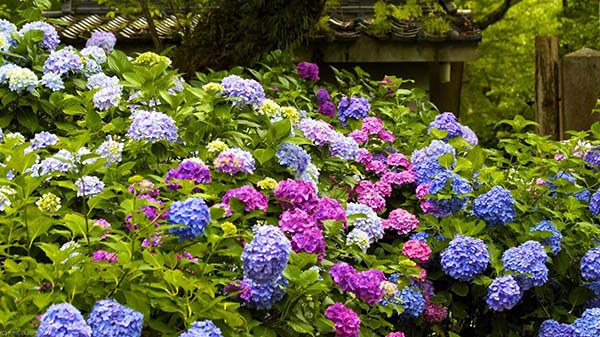
Unfortunately, you can't make a colored hydrangea initially.

As in any delicate matter, moderation is needed here: you need to apply fertilizers to the soil to change the color of the inflorescences gradually, otherwise you can destroy the roots of the bush, and it will die.
Video: how to keep the blue color of hydrangeas
Thus, a beautiful hydrangea can decorate any summer cottage. And if you have already become hostage to the various forms and tones of a dizzying beauty, you should certainly take a course for the impeccably correct implementation of tips and recommendations for buying a seedling, planting and caring for it.

